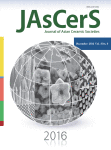
Journal of Asian Ceramic Societies
Scope & Guideline
Connecting minds in the world of ceramics.
Introduction
Aims and Scopes
- Advanced Ceramic Materials:
Research involving the synthesis, characterization, and application of advanced ceramic materials such as piezoelectric, ferroelectric, and bioceramics. - Ceramic Processing Techniques:
Focus on innovative processing methods including additive manufacturing, sintering techniques, and 3D printing of ceramics. - Materials Science and Engineering:
Exploration of the fundamental properties of ceramic materials, including mechanical, thermal, and electrical properties, and their correlations with microstructure. - Environmental and Sustainable Ceramics:
Investigations into eco-friendly materials and processes, including the recycling of waste materials and the development of sustainable ceramic products. - Functional Ceramics:
Research on ceramics with specific functionalities such as photocatalytic, magnetic, and dielectric properties, aimed at various applications in electronics, energy storage, and environmental remediation. - Bioceramics and Biomedical Applications:
Studies focusing on the development and application of bioceramics for medical use, including scaffolds for bone regeneration and drug delivery systems.
Trending and Emerging
- 3D Printing and Additive Manufacturing of Ceramics:
There is a significant increase in research on 3D printing techniques for ceramics, highlighting the potential for creating complex geometries and custom structures in various applications. - Energy Storage and Conversion Materials:
Growing interest in the development of ceramics for energy storage applications, such as solid-state batteries and supercapacitors, aligns with global trends towards renewable energy technologies. - Nanostructured and Smart Ceramics:
Emerging research focuses on the synthesis and application of nanostructured ceramics that exhibit enhanced properties and functionalities, including smart ceramics for sensors and actuators. - Bioactive and Biocompatible Ceramics:
Increasing emphasis on bioceramics for medical applications, particularly in tissue engineering and regenerative medicine, reflects the demand for materials that promote biological interactions. - Environmental Remediation Technologies:
Research on ceramics designed for environmental applications, including photocatalytic degradation and pollutant removal, is gaining traction in response to global environmental challenges. - Hybrid and Composite Ceramics:
The development of hybrid and composite ceramic materials that combine different functionalities is gaining attention, driven by the need for multifunctional materials in various high-tech applications.
Declining or Waning
- Traditional Ceramic Glazing Techniques:
Research related to conventional glazing methods has become less frequent, possibly due to the advent of new materials and techniques that provide better performance and aesthetic qualities. - Low-Tech Ceramic Fabrication:
Publications focusing on traditional, low-tech methods for ceramic fabrication are declining, as the field increasingly embraces advanced manufacturing techniques such as 3D printing and automated processes. - Basic Ceramic Chemistry Studies:
Fundamental studies on the basic chemistry of ceramic materials are waning, possibly overshadowed by more application-oriented research that directly addresses industry needs. - Historical and Cultural Studies of Ceramics:
Research exploring the historical or cultural aspects of ceramics seems to be less emphasized, reflecting a shift towards contemporary applications and technological advancements.
Similar Journals

Fibers
Exploring Innovations in Biomaterials and BeyondFibers is a leading peer-reviewed open access journal published by MDPI, focusing on cutting-edge research within the realm of materials science, particularly in the domains of biomaterials, ceramics and composites, and structural engineering. Established in 2013, the journal has gained recognition for its significant contributions to the field, boasting an impact factor that positions it in the Q2 quartile across multiple categories such as Biomaterials, Ceramics and Composites, Civil and Structural Engineering, and Mechanics of Materials as of 2023. With a Scopus ranking that highlights its prominence—such as in the top 20% in Civil and Structural Engineering—the journal fosters an inclusive platform for academic dialogue and technical advancement. Researchers and professionals can access the journal’s comprehensive articles freely, promoting the dissemination of knowledge that is crucial for the advancement of innovative materials and their applications. Situated in Basel, Switzerland, Fibers continues to be an essential resource for those looking to stay at the forefront of research and technology in material sciences.
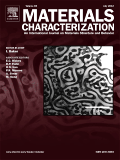
MATERIALS CHARACTERIZATION
Advancing the Frontiers of Materials ScienceMATERIALS CHARACTERIZATION is a leading international journal dedicated to the advancement of knowledge in the field of materials science and engineering. Published by Elsevier Science Inc, this esteemed journal has been disseminating vital research since 1970 and continues to be essential for scholars and industry professionals alike. With an impressive impact reflected in its Q1 quartile rankings across several categories—including Condensed Matter Physics, Materials Science, Mechanical Engineering, and Mechanics of Materials—MATERIALS CHARACTERIZATION stands out as a premier outlet for innovative studies and technical advancements. Researchers can access a wealth of peer-reviewed articles that explore properties, characterization techniques, and applications of materials, fostering interdisciplinary collaboration. With a commitment to high-quality research and comprehensive review processes, the journal plays a crucial role in shaping the future of materials science, making it an invaluable resource for anyone invested in this dynamic field.

MATERIALE PLASTICE
Innovative Insights into Materials and EngineeringMATERIALE PLASTICE is a distinguished academic journal published by REVISTA CHIMIE SRL in Romania, focusing on the fields of Chemistry, Materials Science, and Engineering. With an ISSN of 0025-5289 and an E-ISSN of 2668-8220, this journal has a historical commitment to advancing the study of polymers and plastics since its inception in the early 1970s. Although classified in the Q4 category across multiple disciplines including miscellaneous chemistry and materials chemistry as of 2023, it serves as an important forum for researchers and professionals dedicated to innovative materials research and development. The journal’s resources, though not openly accessible, are pivotal for scholars seeking to deepen their knowledge in the mechanics of materials and interdisciplinary applications. MATERIALE PLASTICE is not only a repository of significant research findings but also a platform for fostering collaboration and discussion among a global audience that continues to strive for scientific excellence in polymer and materials studies.
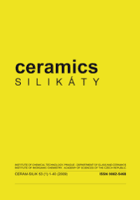
CERAMICS-SILIKATY
Fostering Interdisciplinary Research in Ceramics and CompositesCERAMICS-SILIKATY is a distinguished open-access journal published by the University of Chemistry and Technology, Prague, specializing in the fields of Ceramics and Composites, Analytical Chemistry, Chemical Engineering, and Materials Chemistry. Since its inception in 1991, this journal has played a pivotal role in disseminating cutting-edge research and innovative findings in the study of ceramics, emphasizing both fundamental and applied aspects. With a commitment to accessibility since 2000, CERAMICS-SILIKATY promotes knowledge sharing among researchers, professionals, and students globally. The journal's current standing in the Q3 Quartile across several categories highlights its significant contributions and relevance in the academic community. As a hub for interdisciplinary research, the journal invites submissions that advanced our understanding of ceramic materials and their applications, positioning itself as an essential resource for those engaged in the forefront of materials science.
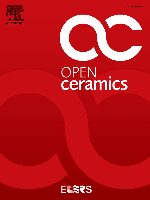
Open Ceramics
Transforming Ideas into Ceramic SolutionsOpen Ceramics is a pioneering journal published by Elsevier, dedicated to the field of materials science, with a particular focus on ceramics and composites. Launched in 2020, this Open Access journal aims to facilitate unrestricted dissemination of cutting-edge research findings while promoting innovative developments in the utilization of ceramic materials across various applications. As of 2023, Open Ceramics has established a commendable presence in several key categories, achieving Q3 in Biomaterials and Q2 rankings in Ceramics and Composites, Electronic, Optical and Magnetic Materials, and Materials Chemistry. The journal's broad scope appeals to a diverse audience of researchers, professionals, and students interested in the advancements within this essential domain of materials science. With a commitment to quality and relevance, Open Ceramics provides a platform for rigorous peer-reviewed research, thereby enhancing the global dialogue in the field and contributing to the ongoing progress of materials innovation.

Journal of Ceramic Science and Technology
Advancing the Frontiers of Ceramic InnovationJournal of Ceramic Science and Technology, published by GOLLER VERLAG GMBH in Germany, serves as a vital platform for advancements in the field of ceramics and composites. Since its inception in 2010, the journal has contributed significantly to the scholarly literature, encompassing a wide range of topics including the development of new ceramic materials, nanocomposites, and their various applications in industries such as electronics, energy, and medicine. Although currently categorized in the Q4 quartile of ceramics and composites and ranked within the lower percentile in Scopus, the journal strives to bridge the gap between fundamental research and practical implementation, fostering innovative solutions to contemporary materials challenges. With an open-access format, it ensures that valuable findings are disseminated widely, promoting collaboration and knowledge sharing among researchers, professionals, and students in the field. As it converges towards 2024, the Journal of Ceramic Science and Technology remains committed to enhancing the understanding and utilization of ceramic materials, making it an indispensable resource for those dedicated to advancing this dynamic area of study.

Transactions of the Indian Ceramic Society
Elevating Understanding in Materials ScienceTransactions of the Indian Ceramic Society is a distinguished journal published by Taylor & Francis Ltd, focusing on the vital field of ceramics and composites. With an ISSN of 0371-750X and an E-ISSN of 2165-5456, this journal serves as a crucial platform for disseminating cutting-edge research and innovations in ceramic materials science. Operating since 1941, it has established a solid reputation within the academic community, currently holding a Q3 ranking in the Ceramics and Composites category according to the 2023 Scopus rankings. Though not an open-access journal, it provides a wealth of insights and findings that can significantly impact both theoretical and practical applications in materials science. The journal aims to facilitate knowledge exchange among researchers, professionals, and students, thereby pushing the boundaries of what is possible in the world of ceramics. It is a valuable resource for anyone looking to advance their understanding and contribute to this ever-evolving field.
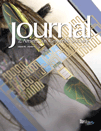
JOURNAL OF THE AMERICAN CERAMIC SOCIETY
Elevating Materials Science through Rigorous ScholarshipJOURNAL OF THE AMERICAN CERAMIC SOCIETY, a prestigious publication within the field of ceramics and materials science, has been at the forefront of advancing research since its inception in 1918 and will continue to be a leading resource through 2024. Published by WILEY, this journal boasts an impressive impact factor, reflecting its strong reputation in the academic community. With its categorization in the Q1 quartile for both Ceramics and Composites and Materials Chemistry, the journal is ranked among the top in its fields, placing it in the 78th and 76th percentiles, respectively, according to Scopus metrics. Although not an open-access journal, it provides critical insights, robust research findings, and a platform for experts to disseminate their work, making it an essential resource for researchers, professionals, and students alike who are engaged in ceramic sciences and materials innovation. The Journal’s meticulous peer-review process ensures the highest quality and relevance of publications, fostering a rich environment for academic discourse and collaboration.

Korean Journal of Materials Research
Pioneering Research for a Dynamic FieldKorean Journal of Materials Research is a pivotal publication in the field of materials science, offering a platform for innovative research and comprehensive reviews in miscellaneous materials applications. Published by the MATERIALS RESEARCH SOC KOREA, this journal has been a valuable resource since its inception in 2007 and continues to disseminate vital findings through 2024. Although currently categorized in Q4 of the Materials Science quartiles, the journal is committed to advancing knowledge and fostering research collaboration within the scientific community. With an ISSN of 1225-0562 and an E-ISSN of 2287-7258, the journal aims to bridge gaps in research and practice, appealing to a diverse audience of researchers, professionals, and students interested in the latest advancements in materials science. While access to content may not be open, the journal's impact in the regional and global research landscape is steadily growing, as indicated by its Scopus ranking in the 7th percentile of General Materials Science. Engage with the Korean Journal of Materials Research to stay at the forefront of materials innovation!
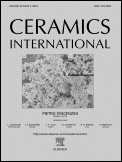
Ceramics International
Pioneering insights in ceramics and composites.Ceramics International is a premier journal published by ELSEVIER SCI LTD, focusing on advancing the field of materials science with a specific emphasis on ceramics and composites. With an impressive impact factor and a top-tier standing in several critical categories, including Q1 rankings in Ceramics and Composites, Electronic, Optical and Magnetic Materials, and Materials Chemistry, this journal serves as a crucial resource for researchers and professionals alike. Established in 1981, it has consistently showcased cutting-edge research in various domains, including surfaces, coatings, and process chemistry technologies, making it invaluable for those advancing theoretical and practical knowledge in these areas. While access is through subscription, the journal’s rich content, profound insights, and rigorous peer-review process ensure high-quality articles that contribute meaningfully to the scientific community. By fostering innovation and collaboration through rigorous research, Ceramics International stands out as an authoritative source for those dedicated to the evolution of materials science.